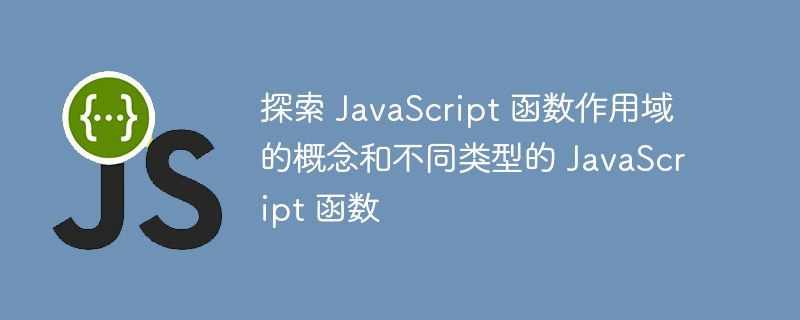所属分类:web前端开发

在 JavaScript 中,不同的作用域允许我们从代码中的不同位置访问函数和变量。我们将在本教程中了解函数范围。此外,我们还将探讨 JavaScript 中不同类型的函数表达式。
当我们在 JavaScript 中创建一个新函数时,它还会创建该特定函数的作用域。这意味着无论我们在函数内声明什么变量或在其中定义嵌套函数,我们只能在函数块内访问它。
如果我们尝试从函数外部访问函数块内部定义的变量,则会出现引用错误。
您可以按照以下语法来定义函数并了解函数作用域。
function function_name(){
var variable = 10; // variable has a function scope.
}
let variable1 = variable;
// we can't access the variable here as it has a function scope.
在上面的语法中,您可以看到我们无法访问函数外部的变量,因为函数块限制了它。
在此示例中,我们创建了示例函数并在具有块作用域的函数内定义了变量。如果我们尝试从函数外部访问 Sample() 函数内部定义的变量,JavaScript 会引发引用错误。
<html>
<body>
<h2>Function Scope in JavaScript</h2>
<div id="output"></div>
<script>
let output = document.getElementById("output");
// defining the function
function sample() {
// variables with function scope.
var website = "TutorialsPoint!";
var language = "JavaScript";
output.innerHTML +=
"You are learning the " +
language +
" programming language on " +
website +
" </br>";
}
sample();
// we can't access language and website variables here.
</script>
</body>
</html>
我们在本例中的示例函数中定义了 nested_function()。我们无法在 sample() 函数 之外调用 nested_funciton(),因为nested_function 在示例函数的范围内。
<html>
<body>
<h2>Function sSope in JavaScript</h2>
<div id="output"></div>
<script>
let output = document.getElementById("output");
function sample() {
// variables with function scope.
var num = 10;
function nested_function() {
// num variables also can be accessed here as nested_function() is
//inside the scope of sample function
var string = "JavaScript";
output.innerHTML +=
"The value of the num variable is " + num + "<br/>";
output.innerHTML +=
"The value of the string variable is " + string + "</br>";
}
// we can call the nested_function() inside the sample() function only
nested_function();
// we can't access the string variable here as the scope of
//nested_function bounds it
}
sample();
</script>
</body>
</html>
根据函数的定义和声明,函数有很多种类型,我们在这里一一学习。
普通函数是所有 JavaScript 开发人员普遍使用的函数。我们可以使用函数名称后跟函数关键字来定义常规函数。
常规函数保持在函数当前作用域的顶部。这意味着我们可以在定义函数之前调用它,但应该在执行之后定义它。
按照此语法定义常规函数。
function function_name(){
// function body
}
在上面的语法中,我们使用了 function 关键字来定义函数。 ‘function_name’是函数的名称,我们可以在大括号内编写函数体的代码。
函数表达式的工作方式也与普通函数类似。不过,不同之处在于它没有任何名称,我们需要将函数表达式存储在变量中。我们可以使用标识符来调用存储它的函数。
JavaScript 逐步计算函数表达式。因此,它没有被提升到作用域的顶部,因此我们无法在声明之前调用它。
按照此语法定义函数表达式。
var function_identifier = function () {
// function body
}
function_identifier();
在上面的语法中,我们仅使用 function 关键字定义了没有名称的函数,并将其存储在 function_identifier 变量中。此外,用户还可以看到我们如何使用 function_identifier 来调用函数表达式。
箭头函数是在 2015 年 JavaScript 的最后一个主要修订版 ES6 中引入的。它是一种较短的语法,用于定义没有函数名称的函数。另外,它被称为表达式和匿名函数,因为它不包含它们的标识。
按照此语法定义箭头函数。
var function_identifier = (params) => {
// function body
}
function_identifier(arguments);
在上面的语法中,我们将箭头函数表达式存储在 function_identifier 中。此外,我们在使用 function_identifier 变量调用函数时传递了箭头函数内的参数和参数。
我们可以在 JavaScript 中创建嵌套函数,并可以使用子函数访问父函数变量。由于子函数包含访问父函数作用域中定义的所有变量的权限,因此我们可以将子函数称为闭包函数。
function parent() {
// variables of the parent
var child = () => {
// variables of child
// access variables of the parent
};
return child;
}
var child = parent();
child();
在上面的语法中,我们可以在子函数内部访问父函数的所有变量,并且父函数返回子函数。因此,我们可以从父函数外部间接调用子函数,即使它是在父函数作用域内定义的。
我们可以使用构造函数来创建对象。
function constructor(property){
this.property = property
}
var string = new constructor("value");
在上面的语法中,我们创建了构造函数的对象。
我们通过本教程中的两个示例了解了嵌套函数的函数作用域如何工作。此外,我们还了解了不同类型的函数。此外,还有一些其他类型的函数,例如递归或回调函数,用户可以在互联网上探索。